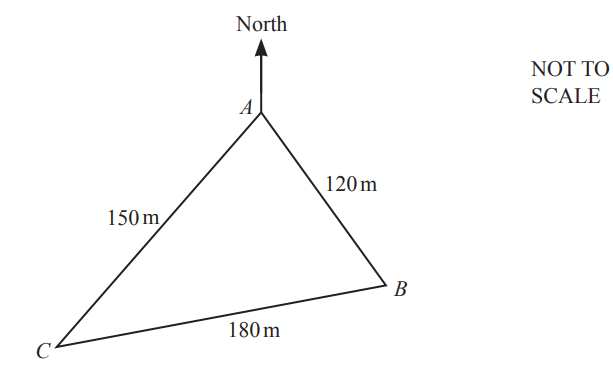Question
(a) Calculate angle ADB.
Angle ADB = …………………………………………
(b) Calculate DC.
DC = ……………………………………. cm
(c) Calculate the shortest distance from C to BD.
…………………………………….. cm
Answer/Explanation
(a) 27[.0] or 26.97… n
(b) 9.19 or 9.192 to 9.193
(c) 6.15 or 6.149 to 6.151…
Question
The diagram shows the positions of three points A, B and C in a field.
(a) Show that BC is 118.1m, correct to 1 decimal place.
(b) Calculate angle ABC.
Angle ABC = …………………………………………
(c) The bearing of C from A is 147°.
Find the bearing of
(i) A from B,
………………………………………….
(ii) B from C.
………………………………………….
(d) Mitchell takes 35 seconds to run from A to C.
Calculate his average running speed in kilometres per hour.
…………………………………. km/h
(e) Calculate the shortest distance from point B to AC.
……………………………………… m
Answer/Explanation
(a)\( BC^{2}=80^{2}+115^{2}-2\times 80\times 115\cos 72\)
118.06…
(b) 67.8 or 67.9 or 67.83 to 67.88
(c)(i) 255
(c)(ii) [00]7.2
(d) 11.8 or 11.82 to 11.83
(e) 76.1 or 76.08 to 76.09
Question

The diagram shows a triangular field, ABC, on horizontal ground.
(a) Olav runs from A to B at a constant speed of 4m/s and then from B to C at a constant speed of 3m/s.
He then runs at a constant speed from C to A.
His average speed for the whole journey is 3.6m/s.
Calculate his speed when he runs from C to A.
m/s [3]
(b) Use the cosine rule to find angle BAC.
Angle BAC = [4]
(c) The bearing of C from A is 210°.
(i) Find the bearing of B from A.[1]
(ii) Find the bearing of A from B.[2]
(d) D is the point on AC that is nearest to B.
Calculate the distance from D to A.
m [2]
Answer/Explanation
Ans:
5(a) 4.29 or 4.285 to 4.286
5(b) 82.8 or 82.81 to 82.82 using cosine rule
5(c)(i) 127.2 or 127.1 to 127.2 or 127
5(c)(ii) 307.2 or 307.1 to 307.2 or 307
5(d) 15 or 14.99 to 15.04

